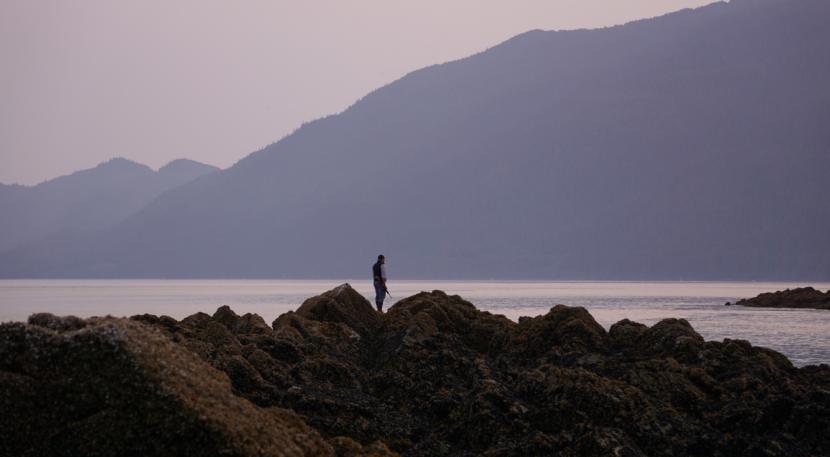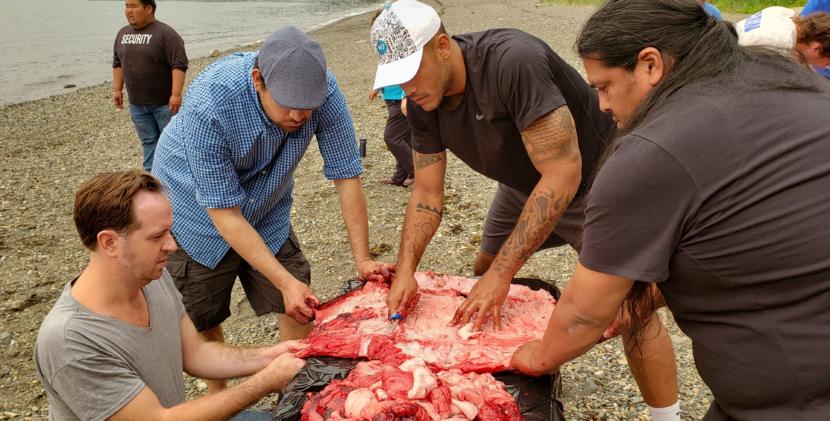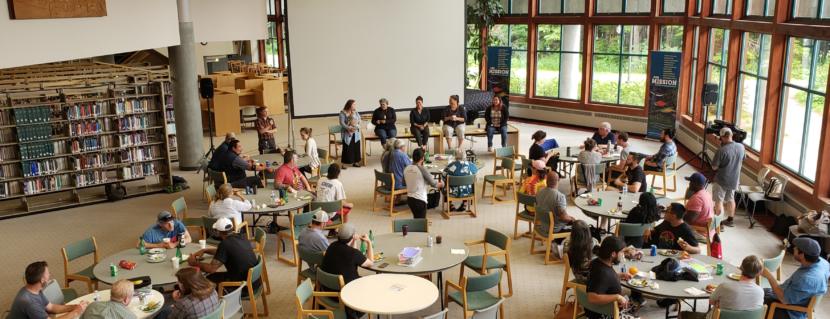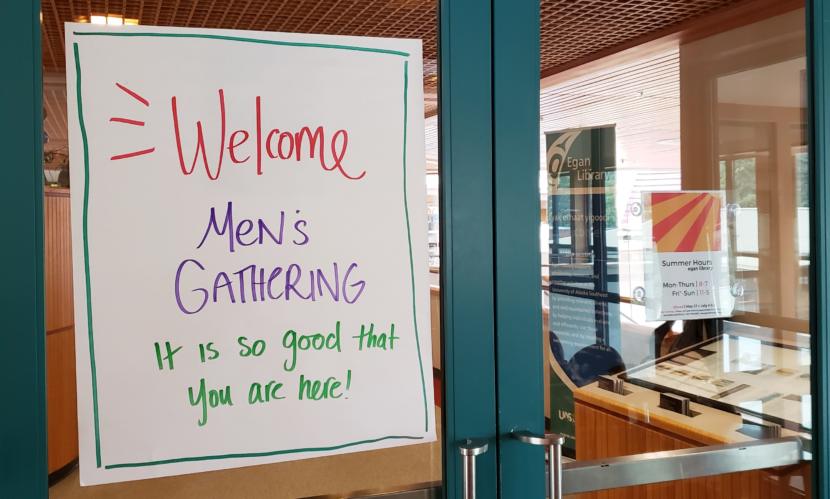
Early Sunday morning aboard an aluminum skiff in Lynn Canal, Johon Echohawk Atkinson of Metlakatla had his eyes trained on his cousin’s husband, who had hopped onto some kelpy, mussel-encrusted rocks with a .22-caliber rifle slung over his shoulder.
“Lyle in his natural elements,” Atkinson said.
Lyle as in Lyle James, a cultural educator and a leader of the Indigenous dance group Woosh.Ji.Een in Juneau. James is Tlingit, Filipino and Hawaiian. He led this seal hunt.
A Men’s Gathering
Atkinson and James are two out of dozens of men from around the state who want to end violence and build healthier communities that converged in Juneau this past weekend.
The organizers — the Alaska Network on Domestic Violence and Sexual Assault, AWARE, Sealaska, and Goldbelt Heritage Foundation — called it a “Men’s Gathering.”
There were panels and discussions about masculinity, colonization, trauma, relationships and healing. As at many conferences, there was a hands-on team building activity the last day. But they didn’t practice trust falls or traverse a ropes course: They picked up filet knives and processed four freshly harvested harbor seals.
But first, James had to do the harvesting.
Seal hunting
Atkinson is from Metlakatla, with Tsimshian and Pawnee roots. Hunting seal was new to him, and he was eager to learn and bring the know-how back to his community. In a lot of Alaska Native communities, he said a loss of culture and identity has caused problems, including domestic violence.
“We also lost our values, you know?” Atkinson said. “Our way of living that has always kept us strong and healthy since time immemorial. So now, with us bringing back our language, with our culture, we’re also bringing back our traditional values, us as men, to be providers and protectors.”
Small waves lapped up against the idling skiff. As Atkinson waited for the hunter to pick his shot, a question from a panel discussion the day before swirled in his head.
“Honestly, that was probably the hardest question that the men answered,” Atkinson said. Because it’s not something men usually talk about.
“And I think that’s part of the problem. … Our mindset was, the way society is, to not talk about love, you know? To not talk about your emotions, to not cry, you know, to not do anything pertaining — that has any feeling. So when those three men were asked, ‘What is love?’ … I’ve never been asked that before, and I’m 38 years old, you know? So it was great, you know, hearing men twice my age, being able to talk about love and become vulnerable in front of an audience of men from all over Alaska.”
After the fourth and final harbor seal of the morning hunt was shot, Lyle James pointed the boat toward a shallow cove and Atkinson grabbed a gaff hook and pulled in the seal.
Lyle James hopped back into the boat. Motoring back to Amalga Harbor, he explained the philosophy that he takes into hunting.
“I never go out and assume that I’m going to get something. I’m just — if a seal’s willing to give itself to us, then I definitely appreciate it,” he said.
They took the seals to Auke Rec. The conference attendees arrived in a caravan. Soon, about a dozen men were wrist deep in seal guts.

Damen Bell-Holter was one of them. He’s multiracial and grew up in Hydaburg, played professional basketball for a few years in the U.S. and Europe, but identified strongly with his village roots, his Haida side especially. Now he works for Sealaska in youth programs. As he sharpened a knife to strip fat off a seal hide, he recalled some lessons from his youth.
“As little kids we were taught, like, every time you go out, deer, everything, deer, seal, fish — we always use every single part of it and you say thanks, we always say thanks every time,” Bell-Holter said. “We make sure that we always use everything. Every piece of the seal, every piece of the deer.”
Leaders from across Alaska
A lot of these guys have leadership roles in their communities running support groups, coaching kids’ basketball, or working directly in social service jobs.
Ethan Candyfire was awed by the experience. He’s Kiowa Apache, Cheyenne and Arapaho, but lives on St. Paul Island in the Bering Sea. He used to work in law enforcement there.
“It’s so reactive, you know?” he said. “A lot of the work that I did was completely after the fact, it’s way after the toxicities and all that all those things happen. So what I realized is, you know, it’s our young people, you know? You kind of have to build them up, you know, you have to put good things — you have to teach them to ask themselves good questions.”
Now he teaches math and coding, and coaches junior high basketball.
“It’s hard in small communities, when people, like, know about some negativity in your life, they know your problems in your situations,” Candyfire said. “But just teaching our youth like, it’s all right, to make, you know, boneheaded mistakes. And that no matter what, don’t feel like you have to stay home, you know, stay away from people. Like, come to these circles, come talk, you know? When you’re uncomfortable, you need to just go ahead and walk in those.”
The seal meat stacked up in one-gallon Ziploc bags. The seal fat went into a big pot to render. It all gets distributed to Elders and conference attendees.
The seal harvest and the men’s gathering aren’t silver bullets. There are many factors that lead to domestic violence and unhealthy relationships. It’s complex.
But Johon Echohawk Atkinson says confronting the issue with other men and creating a space where they can be vulnerable with each other is a huge step.


